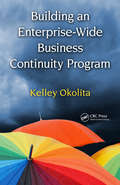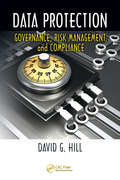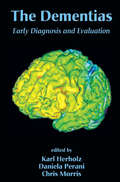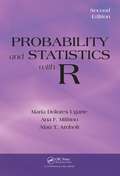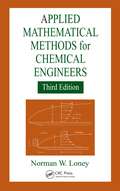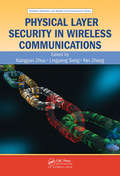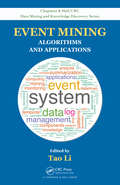- Table View
- List View
Slip, Trip, and Fall Prevention: A Practical Handbook, Second Edition
by Steven Di PillaMore than one million people suffer from a slip, trip, or fall each year and 17,700 died as a result of falls in 2005. They are the number one preventable cause of loss in the workplace and the leading cause of injury in public places. Completely revised, Slip, Trip, and Fall Prevention: A Practical Handbook, Second Edition demonstrates how, with p
Designing for Situation Awareness: An Approach to User-Centered Design, Second Edition
by Mica R. EndsleyLiberally illustrated with actual design examples, this book demonstrates how people acquire and interpret information and examines the factors that undermine this process. The second edition expands and updates the examples throughout to include a wider range of domains and increases the coverage of SA design principles and guidelines to include new areas of development.
Iontronics: Ionic Carriers in Organic Electronic Materials and Devices
by Janelle Leger Magnus Berggren Sue CarterWith contributions from a community of experts, the book focuses on the use of ionic functions to define the principle of operation in polymer devices. It begins by reviewing the scientific understanding and important scientific discoveries made on the electrochemistry of conjugated polymers. It examines the known effects of ion incorporation, including the theory and modulation of electrochemistry in polymer films, and it explores the coupling of electronic and ionic transport in polymer films.
Designing Complex Systems: Foundations of Design in the Functional Domain (Complex and Enterprise Systems Engineering)
by Erik W. AslaksenWithout standardized construction elements such as nuts, bolts, bearings, beams, resistors and the like, the design of physical equipment is hopelessly inefficient, and engineers are continually bogged down with re-designing these elements over and over again. Emphasizing a top-down approach, this volume considers the purpose and basic features of design and how the concept of value can provide a quantitative measure of that wider interaction of the engineered object with its environment. This work also develops the domain in which functional design takes place and explores how the system concept can be embedded in that domain. It proposes a number of functional design elements and develops them in considerable detail, outlining how they can be applied as part of a coherent design framework. For greater understanding of the discussed concepts, numerous examples and analogies are included.
Industrial Steam Systems: Fundamentals and Best Design Practices
by Mojtaba SabetThis clear, easy-to-follow handbook is a useful resource for engineers, architects, and plant operators. A one-stop reference for beginners and advanced readers alike, it describes industrial steam systems design and operation in simple steps. The book explains the system fundamentals, system setup, and required equipment, building, mechanical, and other code requirements, and details the execution of a sample project. It also explains the equipment operation principle and describes best design practices for system setup, piping and instrumentation, equipment sizing, pipe sizing, and equipment selection.
Building an Enterprise-Wide Business Continuity Program
by Kelley OkolitaIf you had to evacuate from your building right now and were told you couldn't get back in for two weeks, would you know what to do to ensure your business continues to operate? Would your staff? Would every person who works for your organization? Increasing threats to business operations, both natural and man-made, mean a disaster could occur at any time. It is essential that corporations and institutions develop plans to ensure the preservation of business operations and the technology that supports them should risks become reality. Building an Enterprise-Wide Business Continuity Program goes beyond theory to provide planners with actual tools needed to build a continuity program in any enterprise. Drawing on over two decades of experience creating continuity plans and exercising them in real recoveries, including 9/11 and Hurricane Katrina, Master Business Continuity Planner, Kelley Okolita, provides guidance on each step of the process. She details how to validate the plan and supplies time-tested tips for keeping the plan action-ready over the course of time. Disasters can happen anywhere, anytime, and for any number of reasons. However, by proactively planning for such events, smart leaders can prepare their organizations to minimize tragic consequences and readily restore order with confidence in the face of such adversity.
Indoor Environmental Quality
by Thad GodishWhen we think of indoor pollution, we usually think of conditions originating from faulty ventilation systems, second hand smoke, and other air borne pollutants. Taking an in-depth, hard science look at the problems of indoor environmental pollution, Indoor Environmental Quality covers all the major indoor contaminants - inorganic, organic, and bio
Piezoelectric Materials and Devices: Applications in Engineering and Medical Sciences
by M. S. VijayaStarting from the fundamentals, this book provides a concise yet complete treatment of piezoelectric materials, an important class of smart materials which are useful as both actuators and sensors. Including case studies, the text introduces different types of dielectric materials, describes the preparation and properties of various piezoelectric materials used in device applications, and presents various engineering and medical applications of piezoelectric materials. It also discusses in detail the design and virtual prototyping of piezoelectric devices using commercially available software tools like ANSYS and PAFEC.
Data Protection: Governance, Risk Management, and Compliance
by David G. HillFailure to appreciate the full dimensions of data protection can lead to poor data protection management, costly resource allocation issues, and exposure to unnecessary risks. Data Protection: Governance, Risk Management, and Compliance explains how to gain a handle on the vital aspects of data protection.The author begins by building the foundatio
The Dementias: Early Diagnosis and Evaluation
by Chris Morris Karl Herholz Daniela PeraniThe only guide to focus primarily on current molecular methods of diagnosis and early stage evaluation, this reference presents the latest techniques and technologies for dementia identification and evaluation, including neuropathological strategies, neuropsychological tests, biomarkers, CT, MRI, functional MRI, PET, and SPECT. Offering practical care and examination guidelines, each chapter provides findings that are particularly relevant for the assessment of disorders such as Alzheimer's disease, dementia with Lewy bodies, vascular dementia, and fronto-temporal dementia.
Catalyst Preparation: Science and Engineering
by John RegalbutoImproving the effectiveness of catalysts is the best way to ensure cleaner, more efficient industrial processes for a wide range of applications. Catalyst Preparation: Science and Engineering explores the optimization of catalytic materials through traditional and novel methods of catalyst preparation, characterization, and monitoring on lab
Design of Enterprise Systems: Theory, Architecture, and Methods
by Ronald GiachettiIn practice, many different people with backgrounds in many different disciplines contribute to the design of an enterprise. Anyone who makes decisions to change the current enterprise to achieve some preferred structure is considered a designer. What is problematic is how to use the knowledge of separate aspects of the enterprise to achieve a globally optimized enterprise. The synthesis of knowledge from many disciplines to design an enterprise defines the field of enterprise engineering.Because enterprise systems are exceedingly complex, encompassing many independent domains of study, students must first be taught how to think about enterprise systems. Specifically written for advanced and intermediate courses and modules, Design of Enterprise Systems: Theory, Architecture, and Methods takes a system-theoretical perspective of the enterprise. It describes a systematic approach, called the enterprise design method, to design the enterprise. The design method demonstrates the principles, models, methods, and tools needed to design enterprise systems. The author uses the enterprise system design methodology to organize the chapters to mimic the completion of an actual project. Thus, the book details the enterprise engineering process from initial conceptualization of an enterprise to its final design.Pedagogical tools available include:For instructors: PowerPoint® slides for each chapter Project case studies that can be assigned as long-term projects to accompany the text Quiz questions for each chapter Business Process Analyzer software available for download For students: Templates, checklists, forms, and models to support enterprise engineering activities The book fills a need for greater design content in engineering curricula by describing how to design enterprise systems. Inclusion of design is also critical for business students, since they must realize the import their decisions may have on the long-term design of the enterprises they work with. The book’s practical focus and project-based approach coupled with the pedagogical tools gives students the knowledge and skills they need to lead enterprise engineering projects.
Sensors and Actuators: Engineering System Instrumentation, Second Edition
by Clarence W. de SilvaAn engineering system contains multiple components that interconnect to perform a specific task. Starting from basic fundamentals through to advanced applications, Sensors and Actuators: Engineering System Instrumentation, Second Edition thoroughly explains the inner workings of an engineering system. The text first provides introductory material-p
Fundamentals in Modeling and Control of Mobile Manipulators (ISSN)
by Shuzhi Sam Ge Zhijun LiMobile manipulators combine the advantages of mobile platforms and robotic arms, extending their operational range and functionality to large spaces and remote, demanding, and/or dangerous environments. They also bring complexity and difficulty in dynamic modeling and control system design.
Alternative Sweeteners
by Lyn O’Brien NaborsThe fourth edition of Alternative Sweeteners follows the same formula as the previous three books by discussing each sweetener in terms of its characteristics. Qualities covered include means of production, physical characteristics, utility, and relative sweetness (compared to sucrose). Technical qualities covered include admixture potential, application, availability, shelf life, transport, metabolism, carcinogenicity, and other toxicity evaluation data. A new chapter on the sweetener Advantame has been added, and new contributors have updated information throughout the book. Also new is a section on how stevia sweeteners have been examined and deemed safe by the Joint FAO/WHO Expert Committee on Food Additives and the US FDA.
Nanoelectrochemistry
by Michael V. Mirkin Shigeru AmemiyaNanoscale electrochemistry has revolutionized electrochemical research and technologies and has made broad impacts in other fields, including nanotechnology and nanoscience, biology, and materials chemistry. Nanoelectrochemistry examines well-established concepts and principles and provides an updated overview of the field and its applications.This
Phosphorus: Chemistry, Biochemistry and Technology, Sixth Edition
by D.E.C. CorbridgeOver two decades have passed since the fifth edition of Phosphorus: Chemistry, Biochemistry and Technology. Major advances in chemistry, materials science, electronics, and medicine have expanded and clarified the role of phosphorus in both our everyday appliances and groundbreaking research. Significantly expanded, updated, and reorganized, this s
Handbook of Fluid Dynamics
by Richard W. JohnsonHandbook of Fluid Dynamics offers balanced coverage of the three traditional areas of fluid dynamics—theoretical, computational, and experimental—complete with valuable appendices presenting the mathematics of fluid dynamics, tables of dimensionless numbers, and tables of the properties of gases and vapors. Each chapter introduces a different fluid dynamics topic, discusses the pertinent issues, outlines proven techniques for addressing those issues, and supplies useful references for further research.Covering all major aspects of classical and modern fluid dynamics, this fully updated Second Edition: Reflects the latest fluid dynamics research and engineering applications Includes new sections on emerging fields, most notably micro- and nanofluidics Surveys the range of numerical and computational methods used in fluid dynamics analysis and design Expands the scope of a number of contemporary topics by incorporating new experimental methods, more numerical approaches, and additional areas for the application of fluid dynamics Handbook of Fluid Dynamics, Second Edition provides an indispensable resource for professionals entering the field of fluid dynamics. The book also enables experts specialized in areas outside fluid dynamics to become familiar with the field.
Probability and Statistics with R
by Ana F. Militino Alan T. Arnholt Maria Dolores UgarteCohesively Incorporates Statistical Theory with R ImplementationSince the publication of the popular first edition of this comprehensive textbook, the contributed R packages on CRAN have increased from around 1,000 to over 6,000. Designed for an intermediate undergraduate course, Probability and Statistics with R, Second Edition explores how some o
Fischer-Tropsch Synthesis, Catalysts, and Catalysis: Advances and Applications
by Burtron H. Davis Mario L. OccelliWith petroleum prices spiraling upward, making synthetic fuels-or "synfuels"-from coal, natural gas, and biomass has become more economically competitive. Advanced energy companies now focus exclusively on alternative fuels, and many oil companies have programs dedicated to developing synthetic fuels. The Fischer-Tropsch process, which uses a colle
Applied Mathematical Methods for Chemical Engineers
by Norman W. LoneyFocusing on the application of mathematics to chemical engineering, Applied Mathematical Methods for Chemical Engineers addresses the setup and verification of mathematical models using experimental or other independently derived data. The book provides an introduction to differential equations common to chemical engineering, followed by examples o
Physical Layer Security in Wireless Communications (Wireless Networks and Mobile Communications)
by Lingyang Song Yan Zhang Xiangyun ZhouPhysical layer security has recently become an emerging technique to complement and significantly improve the communication security of wireless networks. Compared to cryptographic approaches, physical layer security is a fundamentally different paradigm where secrecy is achieved by exploiting the physical layer properties of the communication syst
The Quantum Physics of Atomic Frequency Standards: Recent Developments
by Jacques Vanier Cipriana TomescuUp-to-Date Coverage of Stable and Accurate Frequency StandardsThe Quantum Physics of Atomic Frequency Standards: Recent Developments covers advances in atomic frequency standards (atomic clocks) from the last several decades. It explains the use of various techniques, such as laser optical pumping, coherent population trapping, laser cooling, and e
Event Mining: Algorithms and Applications (Chapman & Hall/CRC Data Mining and Knowledge Discovery Series)
by Tao LiWith a focus on computing system management, this book presents a variety of event mining approaches for improving the quality and efficiency of IT service and system management. It covers different components in the data-driven framework, from system monitoring and event generation to pattern discovery and summarization. The book explores recent developments in event mining, such as new clustering-based approaches, as well as various applications of event mining, including social media.
Handbook of Magnetic Measurements (ISSN)
by Slawomir TumanskiCollecting state-of-the-art knowledge from information scattered throughout the literature, this handbook describes magnetic materials and sensors, the testing of magnetic materials, and applications of magnetic measurements. It presents an up-to-date, accessible account of modern magnetic measurement techniques. The book discusses the fundamentals of magnetism and covers contemporary magnetic materials and sensors. It also explores applications of magnetic diagnostics in medicine, magnetoarcheology, and magnetic imaging. An extensive list of references is included at the end of each chapter.





